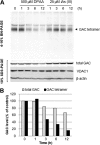Diphenylarsinic acid promotes degradation of glutaminase C by mitochondrial Lon protease
- PMID: 22493432
- PMCID: PMC3365764
- DOI: 10.1074/jbc.M112.362699
Diphenylarsinic acid promotes degradation of glutaminase C by mitochondrial Lon protease
Abstract
Glutaminase C (GAC), a splicing variant of the kidney-type glutaminase (KGA) gene, is a vital mitochondrial enzyme protein that catalyzes glutamine to glutamate. Earlier studies have shown that GAC proteins in the human hepatocarcinoma cell line, HepG2, were down-regulated by diphenylarsinic acid (DPAA), but the mechanism by which DPAA induced GAC protein down-regulation remained poorly understood. Here, we showed that DPAA promoted GAC protein degradation without affecting GAC transcription and translation. Moreover, DPAA-induced GAC proteolysis was mediated by mitochondrial Lon protease. DPAA insolubilized 0.5% Triton X-100-soluble GAC protein and promoted the accumulation of insoluble GAC in Lon protease knockdown cells. DPAA destroyed the native tetrameric GAC conformation and promoted an increase in the unassembled form of GAC when DPAA was incubated with cell extracts. Decreases in the tetrameric form of GAC were observed in cells exposed to DPAA, and decreases occurred prior to a decrease in total GAC protein levels. In addition, decreases in the tetrameric form of GAC were observed independently with Lon protease. Mitochondrial heat shock protein 70 is known to be an indispensable protein that can bind to misfolded proteins, thereby supporting degradation of proteins sensitive to Lon protease. When cells were incubated with DPAA, GAC proteins that can bind with mtHsp70 increased. Interestingly, the association of mtHsp70 with GAC protein increased when the tetrameric form of GAC was reduced. These results suggest that degradation of native tetrameric GAC by DPAA may be a trigger in GAC protein degradation by Lon protease.
Figures










Similar articles
-
Down-regulation of glutaminase C in human hepatocarcinoma cell by diphenylarsinic acid, a degradation product of chemical warfare agents.Toxicol Appl Pharmacol. 2007 May 1;220(3):262-70. doi: 10.1016/j.taap.2007.01.009. Epub 2007 Jan 24. Toxicol Appl Pharmacol. 2007. PMID: 17321558
-
Structure-effect relationship in the down-regulation of glutaminase in cultured human cells by phenylarsenic compounds.Toxicology. 2009 Apr 28;258(2-3):157-63. doi: 10.1016/j.tox.2009.01.020. Epub 2009 Jan 24. Toxicology. 2009. PMID: 19428935
-
Phosphorylation of human TFAM in mitochondria impairs DNA binding and promotes degradation by the AAA+ Lon protease.Mol Cell. 2013 Jan 10;49(1):121-32. doi: 10.1016/j.molcel.2012.10.023. Epub 2012 Nov 29. Mol Cell. 2013. PMID: 23201127 Free PMC article.
-
Upregulation of the mitochondrial Lon Protease allows adaptation to acute oxidative stress but dysregulation is associated with chronic stress, disease, and aging.Redox Biol. 2013 Feb 9;1(1):258-64. doi: 10.1016/j.redox.2013.01.015. Redox Biol. 2013. PMID: 24024159 Free PMC article. Review.
-
Mitochondrial Lon Protease and Cancer.Adv Exp Med Biol. 2017;1038:173-182. doi: 10.1007/978-981-10-6674-0_12. Adv Exp Med Biol. 2017. PMID: 29178076 Review.
Cited by
-
Glutaminase regulation in cancer cells: a druggable chain of events.Drug Discov Today. 2014 Apr;19(4):450-7. doi: 10.1016/j.drudis.2013.10.008. Epub 2013 Oct 16. Drug Discov Today. 2014. PMID: 24140288 Free PMC article. Review.
-
LonP1 Differently Modulates Mitochondrial Function and Bioenergetics of Primary Versus Metastatic Colon Cancer Cells.Front Oncol. 2018 Jul 9;8:254. doi: 10.3389/fonc.2018.00254. eCollection 2018. Front Oncol. 2018. PMID: 30038898 Free PMC article.
-
Cross Talk of Proteostasis and Mitostasis in Cellular Homeodynamics, Ageing, and Disease.Oxid Med Cell Longev. 2016;2016:4587691. doi: 10.1155/2016/4587691. Epub 2016 Feb 9. Oxid Med Cell Longev. 2016. PMID: 26977249 Free PMC article. Review.
-
Mitochondrial Lon protease at the crossroads of oxidative stress, ageing and cancer.Cell Mol Life Sci. 2015 Dec;72(24):4807-24. doi: 10.1007/s00018-015-2039-3. Epub 2015 Sep 12. Cell Mol Life Sci. 2015. PMID: 26363553 Free PMC article. Review.
-
The 'Achilles Heel' of Metabolism in Renal Cell Carcinoma: Glutaminase Inhibition as a Rational Treatment Strategy.Kidney Cancer. 2019 Feb 5;3(1):15-29. doi: 10.3233/KCA-180043. Kidney Cancer. 2019. PMID: 30854496 Free PMC article. Review.
References
-
- Ishii K., Tamaoka A., Otsuka F., Iwasaki N., Shin K., Matsui A., Endo G., Kumagai Y., Ishii T., Shoji S., Ogata T., Ishizaki M., Doi M., Shimojo N. (2004) Diphenylarsinic acid poisoning from chemical weapons in Kamisu, Japan. Ann. Neurol. 56, 741–745 - PubMed
-
- Kita K., Suzuki T., Ochi T. (2007) Down-regulation of glutaminase C in human hepatocarcinoma cell by diphenylarsinic acid, a degradation product of chemical warfare agents. Toxicol. Appl. Pharmacol. 220, 262–270 - PubMed
-
- Curthoys N. P., Watford M. (1995) Regulation of glutaminase activity and glutamine metabolism. Annu. Rev. Nutr. 15, 133–159 - PubMed
-
- Elgadi K. M., Meguid R. A., Qian M., Souba W. W., Abcouwer S. F. (1999) Cloning and analysis of unique human glutaminase isoforms generated by tissue-specific alternative splicing. Physiol. Genomics 1, 51–62 - PubMed
-
- Holcomb T., Taylor L., Trohkimoinen J., Curthoys N. P. (2000) Isolation, characterization, and expression of a human brain mitochondrial glutaminase cDNA. Mol. Brain Res. 76, 56–63 - PubMed
Publication types
MeSH terms
Substances
LinkOut - more resources
Full Text Sources

